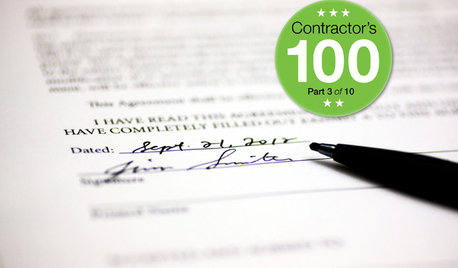What is essential to include in remodel contracts?
House123
12 years ago
Related Stories

BUDGETING YOUR PROJECTConstruction Contracts: What Are General Conditions?
Here’s what you should know about these behind-the-scenes costs and why your contractor bills for them
Full Story
BUDGETING YOUR PROJECTConstruction Contracts: What to Know About Estimates vs. Bids
Understanding how contractors bill for services can help you keep costs down and your project on track
Full Story
WORKING WITH PROSConstruction Contracts: How to Understand What You Are Buying
Learn how plans, scope of work and specifications define the work to be completed
Full Story
REMODELING GUIDES13 Essential Questions to Ask Yourself Before Tackling a Renovation
No one knows you better than yourself, so to get the remodel you truly want, consider these questions first
Full Story
DESIGN PRACTICEContracting Practice: Marketing Your Business
To keep those projects rolling in, combine old-school techniques with the latest in high-tech networking
Full Story
MOST POPULAROrganizing? Don’t Forget the Essential First Step
Simplify the process of getting your home in order by taking it one step at a time. Here’s how to get on the right path
Full Story
CONTRACTOR TIPSWhat to Look for in a Contractor's Contract
10 basic ingredients for a contract will help pave the way to remodel happiness
Full Story
BATHROOM DESIGNPowder Room Essentials to Keep Guests Happy
Set out these bathroom necessities (hello, hand towels) to make your company comfortable and your parties run smoothly
Full Story
STANDARD MEASUREMENTSKey Measurements to Help You Design Your Home
Architect Steven Randel has taken the measure of each room of the house and its contents. You’ll find everything here
Full Story
SHOP HOUZZShop Houzz: Up to 75% Off Home Bar Essentials
Remodel your home bar with stools, wine refrigerators, lighting and more
Full Story0
More Discussions










lucillle
renovator8
Related Professionals
Pleasant Grove Kitchen & Bathroom Designers · Auburn Kitchen & Bathroom Remodelers · Chandler Kitchen & Bathroom Remodelers · Eureka Kitchen & Bathroom Remodelers · Franconia Kitchen & Bathroom Remodelers · Appleton Interior Designers & Decorators · Conneaut General Contractors · Leon Valley General Contractors · Linton Hall General Contractors · Markham General Contractors · Millbrae General Contractors · Mishawaka General Contractors · Palestine General Contractors · Waipahu General Contractors · Westerly General Contractorsbill_g_web
renovator8
brickeyee
renovator8
bill_g_web
renovator8
renovator8
brickeyee
renovator8
renovator8
bill_g_web
House123Original Author
renovator8
CHARLIEP57
renovator8
brickeyee
renovator8
Beenana
virgilcarter
renovator8
kirkhall